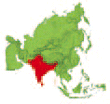DK People & Places: Southern Asia
- WHY DO HINDU PILGRIMS GATHER AT VARANASI?
- HOW ARE HIKERS DAMAGING THE HIMALAYAS?
- WHY IS BANGLADESH PRONE TO FLOODING?
- WHICH ISOLATED COUNTRY IS RULED BY THE DRAGON KING?
- WHAT IS CITY LIFE LIKE IN INDIA?
- WHICH CROP IS IMPORTANT TO SRI LANKA?
- HOW DID GREAT BRITAIN INFLUENCE INDIA?
- FACTFILE: SOUTHERN ASIA
- FIND OUT MORE
Southern Asia, home to over one-fifth of the world’s population, is bordered by the sea to the south and the Himalayan mountains to the north. The region has a great variety of landscapes and climates, with dry, sandy desert in the northwest, and tropical rainforests in the south. In the east, three major rivers—the Brahmaputra, the Meghna, and the Ganges—flow together toward the Bay of Bengal, where they form the world’s largest delta.
The city of Varanasi is sacred to Hindus, who form 90 percent of India’s population. Every year, millions of pilgrims gather on the stone steps called ghats along the high banks of the Ganges River. Here they pray, meditate, and purify themselves in the river’s holy waters. The dead are cremated on funeral pyres and their ashes are sprinkled onto the surface of the water.
The large number of hikers visiting the Himalayas each year are damaging the fragile mountain environment and threatening its ecology. Every year, 300,000 tourists visit Nepal to walk on the slopes of Mount Everest and other major peaks. These visitors erode mountain trails and often leave behind vast quantities of garbage.
Large parts of central and southern Bangladesh are flat, low-lying river plains, which flood during the summer monsoon rains. In good years, the floods water the crops and fertilize the fields. In bad years, they cause devastation by surging over flood defenses and sweeping away villages, livestock, and crops.
Water levels in Bangladesh rise 20 ft (6 m) above normal during the annual monsoon rains. Flood-waters can destroy animals, crops, and homes, and spread disease. More than 50 percent of Bangladeshis live in extreme poverty, and the country is too poor to invest in large-scale flood defenses, such as dams.
Bhutan is a small Buddhist kingdom in the Himalayas, ruled by a monarch called the Dragon King. The country has little contact with the outside world, although television was introduced in 1999. Most of the population makes a living from farming.
India’s two largest cities are crowded, bustling places where modern high-rise office buildings stand next to ancient temples, monuments, and mosques. Calcutta is a major industrial city, and Mumbai (Bombay) is the center of India’s huge film industry. As more people move from the countryside in search of work, overcrowding in the cities’ slums is a growing problem.
The island of Sri Lanka has over 2,000 tea plantations and is the world’s largest tea exporter. The best tea grows on the hillsides in the cooler, central highlands. Tea is harvested by hand—machines would bruise the fragile leaves and spoil their delicate flavor. The leaves are then rolled, dried, and packed for export.
India was a British colony from the mid-19th century until 1947, when it gained its independence. British influences can still be seen in the region today, such as the widespread use of English, the European style of architecture, the vast rail network, the passion for cricket, and in the legal and political systems.
Capital city: Islamabad
Area: 310,401 sq miles (803,940 sq km)
Population:149 million
Official language: Urdu
Major religion: Sunni Muslim
Currency: Pakistani rupee
Capital city: New Delhi
Area: 1,269,338 sq miles (3,287,590 sq km)
Population: 1.04 billion
Official languages: Hindi and English
Major religion: Hindu
Currency: Indian rupee
Capital city: Male’
Area: 116 sq miles (300 sq km)
Population: 309,000
Official language: Dhivehi
Major religion: Sunni Muslim
Currency: Rufiyaa
Capital city: Colombo
Area: 25,332 sq miles (65,610 sq km)
Population: 19.3 million
Official languages: Sinhala, Tamil, and English
Major religion: Buddhist
Currency: Sri Lanka rupee
Capital city: Kathmandu
Area: 54,363 sq miles (140,800 sq km)
Population: 24.2 million
Official language: Nepali
Major religion: Hindu
Currency: Nepalese rupee
Capital city: Dhaka
Area: 55,598 sq miles (144,000 sq km)
Population: 143 million
Official language: Bengali
Major religion: Muslim (mainly Sunni)
Currency: Taka

